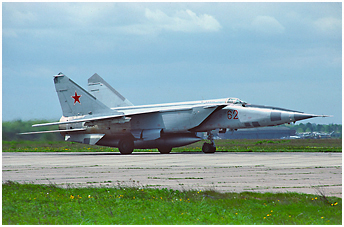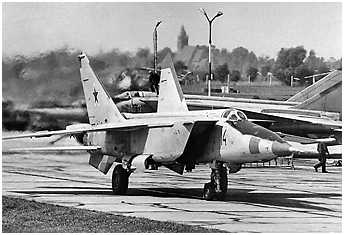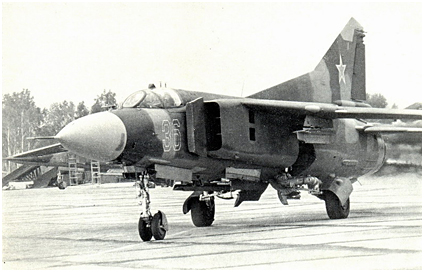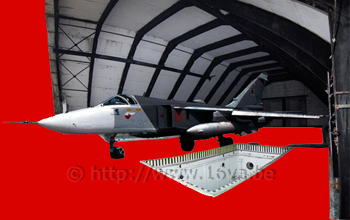Nuclear "Foxbats"
 1989, the year when the Soviet empire fell apart, marked the end of the deployment of the outdated Yak-28 in Germany.
One of the first discoveries made at Werneuchen after the withdrawal of the Russians was a special "GRANIT-2"
storage bunker, the existence of which seemed to contradict the basing there of reconnaisance and electronic
warfare aircraft - specifically the Yak-27, Yak-28 and MiG-25. A full analysis of this particular bunker and its
immediate surroundings, and a detailed look at the deployment history of that air base, was necessary to solve
this puzzle. The stationing at Werneuchen of offensive weapons ended, as is well known, in 1968 with the
withdrawal of all frontal bombers (those of the 132.BAD) from the GDR. A reconnaissance unit, the 931.OGRAP,
was transferred from Stendal to Werneuchen. Reconnaissance aircraft can obviously be modified to drop bombs,
but did they also have a nuclear capability? Some years ago, the author of this article met a Yak-28 pilot from
that time. Surpirsingly, Guards Captain Oleg Kozlov now lives in Germany, in Hamburg. From 1986 to 1989, he was
one of the few to fly the Yak-28PP 'Brewer-E' electronic warfare variant, and he spoke freely about his time at
Werneuchen, saying:
1989, the year when the Soviet empire fell apart, marked the end of the deployment of the outdated Yak-28 in Germany.
One of the first discoveries made at Werneuchen after the withdrawal of the Russians was a special "GRANIT-2"
storage bunker, the existence of which seemed to contradict the basing there of reconnaisance and electronic
warfare aircraft - specifically the Yak-27, Yak-28 and MiG-25. A full analysis of this particular bunker and its
immediate surroundings, and a detailed look at the deployment history of that air base, was necessary to solve
this puzzle. The stationing at Werneuchen of offensive weapons ended, as is well known, in 1968 with the
withdrawal of all frontal bombers (those of the 132.BAD) from the GDR. A reconnaissance unit, the 931.OGRAP,
was transferred from Stendal to Werneuchen. Reconnaissance aircraft can obviously be modified to drop bombs,
but did they also have a nuclear capability? Some years ago, the author of this article met a Yak-28 pilot from
that time. Surpirsingly, Guards Captain Oleg Kozlov now lives in Germany, in Hamburg. From 1986 to 1989, he was
one of the few to fly the Yak-28PP 'Brewer-E' electronic warfare variant, and he spoke freely about his time at
Werneuchen, saying:
 "Our air base also had its share of the glukhonyemye (deaf mutes)." [These were the
personnel responsible for the nuclear weapons, who were not allowed to speak with other people about their work.
Even if other military personnel asked, they never answered, hence the nickname. These officers were deemed so
important that they even had permission to buy a car in East Germany, which Russian personnel were not normally
allowed to do. At Werneuchen, for instance, only the base commander and the commander of the nuclear personnel
could do so - it was a great thing, for a normal person in the GDR had to wait 12 years for a private car.]
Kozlov continued: "I served as a pilot in the 2nd squadron of the 931st Separate Guards Reconnaissance Aviation
Regiment. The MiG-25 reconnaissance aircraft of the 1st squadron were also intended to deploy nuclear weapons.
The loading exercises for this were carried out mostly at night. While maintaining radio silence there were
several [conventional] training flights over the Belorussian SSR. 500kg dummy bombs were dropped from an altitude of 20km over
the Luninets bombing range.
Even though I received the flight engineer qualification at the Barnaul Flight School
(BVVAUL) I did not receive any special training concerning the deployment of nuclear weapons. My Yak-28PP could
only carry two UB-16 rocket pods under its wings, out of which 57mm S-5P electronic jamming devices could be
discharged."
"Our air base also had its share of the glukhonyemye (deaf mutes)." [These were the
personnel responsible for the nuclear weapons, who were not allowed to speak with other people about their work.
Even if other military personnel asked, they never answered, hence the nickname. These officers were deemed so
important that they even had permission to buy a car in East Germany, which Russian personnel were not normally
allowed to do. At Werneuchen, for instance, only the base commander and the commander of the nuclear personnel
could do so - it was a great thing, for a normal person in the GDR had to wait 12 years for a private car.]
Kozlov continued: "I served as a pilot in the 2nd squadron of the 931st Separate Guards Reconnaissance Aviation
Regiment. The MiG-25 reconnaissance aircraft of the 1st squadron were also intended to deploy nuclear weapons.
The loading exercises for this were carried out mostly at night. While maintaining radio silence there were
several [conventional] training flights over the Belorussian SSR. 500kg dummy bombs were dropped from an altitude of 20km over
the Luninets bombing range.
Even though I received the flight engineer qualification at the Barnaul Flight School
(BVVAUL) I did not receive any special training concerning the deployment of nuclear weapons. My Yak-28PP could
only carry two UB-16 rocket pods under its wings, out of which 57mm S-5P electronic jamming devices could be
discharged."
 Due to the location of the base, right next to the Berlin Control Zone, the West was always well-informed
of goings-on at Werneuchen. In 1971, reconnaissance photos showed the first prefab concrete parts for the construction
of a special weapons storage bunker. In the years that followed it was built out of sight on the site of a former
Wehrmacht rifle range. The first MiG-25RB reconnaissance aircraft at this base were spotted in November
1974, having replaced the Yak-27R "Mangrove." From this point at the latest, nuclear weapons capable of being deployed
from the MiG-25RBs were stored on the base.
Alongside those stationed at Werneuchen, MiG-25RBs from Brzeg, Poland,
also had a nuclear cpability. These were the only bases in Eastern Europe to which MiG-25RBs of Frontal Aviation were
deployed with a nuclear capability. The 164.OGRAP of the 37.VA received its first MiG-25RBs at the end of 1973. The dual
nuclear capacity thereof was assumed through Western information-gathering by 1975, and their combat effectiveness was
estimated as follows: "The selective deployment of tactical nuclear weapons from high altitude and with great speed
through "Foxbat-Bs" in their secondary function, due to known observations of reconnaissance units stationed in
Brzeg, cannot be excluded."
Due to the location of the base, right next to the Berlin Control Zone, the West was always well-informed
of goings-on at Werneuchen. In 1971, reconnaissance photos showed the first prefab concrete parts for the construction
of a special weapons storage bunker. In the years that followed it was built out of sight on the site of a former
Wehrmacht rifle range. The first MiG-25RB reconnaissance aircraft at this base were spotted in November
1974, having replaced the Yak-27R "Mangrove." From this point at the latest, nuclear weapons capable of being deployed
from the MiG-25RBs were stored on the base.
Alongside those stationed at Werneuchen, MiG-25RBs from Brzeg, Poland,
also had a nuclear cpability. These were the only bases in Eastern Europe to which MiG-25RBs of Frontal Aviation were
deployed with a nuclear capability. The 164.OGRAP of the 37.VA received its first MiG-25RBs at the end of 1973. The dual
nuclear capacity thereof was assumed through Western information-gathering by 1975, and their combat effectiveness was
estimated as follows: "The selective deployment of tactical nuclear weapons from high altitude and with great speed
through "Foxbat-Bs" in their secondary function, due to known observations of reconnaissance units stationed in
Brzeg, cannot be excluded."
| Nuclear weapons |
 The Western allies were also comparatively knowledgeable about activities at the fighter
base at Zerbst, located right underneath the southern air corridor to Berlin. A first-hand insight is provided
by Boris Rytschilo, a technical officer who served in the 35.IAP for several years and published a chronicle of his
unit in 2000.
It reads: "The MiG-23M was introduced almost simultaneously in all three Fighter Regiments ["Flogger-B"
introduction occured with the 31.GvIAP at Falkenberg in 1973, the 35.IAP at Zerbst in 1975, and the 787.IAP at
Finow and 85.GvIAP at Merseburg in 1976] of the 16.VA. At this time the MiG-23M was the most modern and complex
aircraft of the Group of Soviet Forces in Germany. However, from 1980 on the MiG-23M was already considered obsolete...
only five years after its introduction. During that time the improved MiG-23ML "Flogger-G" was delivered to other
Fighter Regiments. The training of air-to-ground missions increased in frequency.
The Western allies were also comparatively knowledgeable about activities at the fighter
base at Zerbst, located right underneath the southern air corridor to Berlin. A first-hand insight is provided
by Boris Rytschilo, a technical officer who served in the 35.IAP for several years and published a chronicle of his
unit in 2000.
It reads: "The MiG-23M was introduced almost simultaneously in all three Fighter Regiments ["Flogger-B"
introduction occured with the 31.GvIAP at Falkenberg in 1973, the 35.IAP at Zerbst in 1975, and the 787.IAP at
Finow and 85.GvIAP at Merseburg in 1976] of the 16.VA. At this time the MiG-23M was the most modern and complex
aircraft of the Group of Soviet Forces in Germany. However, from 1980 on the MiG-23M was already considered obsolete...
only five years after its introduction. During that time the improved MiG-23ML "Flogger-G" was delivered to other
Fighter Regiments. The training of air-to-ground missions increased in frequency.
During night-time - in order to avoid enemy detection - the 2nd squadron practiced the attachement of special bombs. In about 1982 our Regiment was
transformed in to a Fighter-Bomber Regiment (the 35.APIB). It was not until the end of the 1980s, when we received modern
MiG-29s, that we were reinstated as a Fighter Regiment. Our MiG-23Ms remained as fighter-bombers until 1989."

 It was not only at Zerbst that the MiG-23 was intended for use as a nuclear strike aircraft. Eyewitnesses confirm such training
methods at Kolobrzeg air base in the norh-west of Poland. This was the home base of the 871.IAP of the 4.VA (formerly
37.VA), which was equipped with MiG-23Ms from the end of 1973. This airfield also had a Granit bunker which was
suitable for the temporary storage of 'special' weaponry. A conspicuous loading ramp close to the bunker allowed
the fast loading and unloading of the bunker's dangerous contents, typical of such storage sites. Warrant
officer Pavel Sutkin reported the following on the internet in 2005: "The methodical instructions concerning the
attachment of the RN-28 [or is it RN-40?] special into the MiG-23M was intended to enable the flight crews of the 1st squadron to
attach the special bomb under realistic conditions even without the technicians being present. The enty to the
hardened shelter [Soviet HS type AU-11] was gained through the exhaust channel, which was secured by guards and kept
closed during training. The slits between the front doors of the shelter were closed to a margin of 15 to 20cm and
covered with tarps to avoid any outside visual identification. A man also stood guard there. All pilos of the 1st squadron
were present to watch the procedure..."
It was not only at Zerbst that the MiG-23 was intended for use as a nuclear strike aircraft. Eyewitnesses confirm such training
methods at Kolobrzeg air base in the norh-west of Poland. This was the home base of the 871.IAP of the 4.VA (formerly
37.VA), which was equipped with MiG-23Ms from the end of 1973. This airfield also had a Granit bunker which was
suitable for the temporary storage of 'special' weaponry. A conspicuous loading ramp close to the bunker allowed
the fast loading and unloading of the bunker's dangerous contents, typical of such storage sites. Warrant
officer Pavel Sutkin reported the following on the internet in 2005: "The methodical instructions concerning the
attachment of the RN-28 [or is it RN-40?] special into the MiG-23M was intended to enable the flight crews of the 1st squadron to
attach the special bomb under realistic conditions even without the technicians being present. The enty to the
hardened shelter [Soviet HS type AU-11] was gained through the exhaust channel, which was secured by guards and kept
closed during training. The slits between the front doors of the shelter were closed to a margin of 15 to 20cm and
covered with tarps to avoid any outside visual identification. A man also stood guard there. All pilos of the 1st squadron
were present to watch the procedure..."
 Un Su-24M du 116.GvBAP se trouvait vraisemblablement en permanence prêt à être armé de bombes
nucléaires dans la hangarette "Paterny" (montage photo avec un Su-24MR du 11.ORAP). © S.Meeter.
Un Su-24M du 116.GvBAP se trouvait vraisemblablement en permanence prêt à être armé de bombes
nucléaires dans la hangarette "Paterny" (montage photo avec un Su-24MR du 11.ORAP). © S.Meeter.
A Su-24M of the 116.GvBAP was probably always ready to be loaded with nuclear bombs inside
the 'Paterny' shelter (photomontage with a Su-24MR of the 11.ORAP). © S.Meeter.
"The detachment had difficulties positioning the ammo trailers with the RN-28
under the MiG-23M. The specialists then attached the bomb to the special mount [BD3-66-23N] under the
fuselage, which was rather difficult due to the curves of the airplane structure. Afterwards they removed the
much-lightened ammo trailers. At this particular moment, a yound pilot who was sitting in the cockpit and was simulating
a combat readiness Level One activated the malfunction discard lever... presumably by accident. The bomb, of course,
fell forcefully to the ground. A guard says that the tarps between the large bunker doors were ripped off and the
entire 1st squadron ran away madly and disappeared in an unknown direction. Apparently they hid themselves so well
that they were not found until the next morning. They had found the hardened shelter in the reserve command post."
 Three Fighter Regiments of Frontal Aviation in Eastern Europe are known to have had a dual nuclear capability from
the mid-1970s. These units constantly had nuclear weaponry stored at their bases. Stargard in Poland, Milovice in
Czechoslovakia and Kiskunlachaza in Hungary all had Granit-2 bunkers that allowed the storage of nuclear weapons
(1).
The capacity of each storage site was sufficient to equip an entire fighter squadron with tactical nuclear weapons.
Freefall nuclear weapons of Soviet Frontal Aviation in Czecholsovakia were stored exclusively at Milovice. After
the Soviet occupation of Czechoslovakia in 1968, this airfield was upgraded to a "multi-purpose" air base. Along with
helicopters, transports and liaison aircraft, this base was also the home to the 114.IAP which flew MiG-21s, MiG-23s
and MiG-29s for 20 years. Nuclear weapons were stored in a state of constant readiness in a Granit-2 bunker on the edge
of the airfield. At Kiskunlachaza, south of Budapest, this related to the 2nd squardron of the 14.GvIAP, a unit
which started flying MiG-23MLs in 1979. These were replaced with MiG-29 'Fulcrum-Cs' in 1986, which allowed the unit
to retain its nuclear capability.
The 159.IAP at Stargard-Kluczewo in western Poland flew MiG-21s until the end of
the 1980s, when it received Su-27 'Flankers'. The author is uncertain as to whether or not the Su-27 was conceived to
have a nuclear capability. By then, though, the Cold War was all but over, and this nuclear arsenal in Eastern Europe
had had its day.
Three Fighter Regiments of Frontal Aviation in Eastern Europe are known to have had a dual nuclear capability from
the mid-1970s. These units constantly had nuclear weaponry stored at their bases. Stargard in Poland, Milovice in
Czechoslovakia and Kiskunlachaza in Hungary all had Granit-2 bunkers that allowed the storage of nuclear weapons
(1).
The capacity of each storage site was sufficient to equip an entire fighter squadron with tactical nuclear weapons.
Freefall nuclear weapons of Soviet Frontal Aviation in Czecholsovakia were stored exclusively at Milovice. After
the Soviet occupation of Czechoslovakia in 1968, this airfield was upgraded to a "multi-purpose" air base. Along with
helicopters, transports and liaison aircraft, this base was also the home to the 114.IAP which flew MiG-21s, MiG-23s
and MiG-29s for 20 years. Nuclear weapons were stored in a state of constant readiness in a Granit-2 bunker on the edge
of the airfield. At Kiskunlachaza, south of Budapest, this related to the 2nd squardron of the 14.GvIAP, a unit
which started flying MiG-23MLs in 1979. These were replaced with MiG-29 'Fulcrum-Cs' in 1986, which allowed the unit
to retain its nuclear capability.
The 159.IAP at Stargard-Kluczewo in western Poland flew MiG-21s until the end of
the 1980s, when it received Su-27 'Flankers'. The author is uncertain as to whether or not the Su-27 was conceived to
have a nuclear capability. By then, though, the Cold War was all but over, and this nuclear arsenal in Eastern Europe
had had its day.

This chapter is an adaptation of the article entitled 'Nuclear Power' by Stefan Büttner, published in the March 2009 issue of Aircraft Illustrated (Ian Allan Publishing) - see mulitmedia. With special thanks to Stefan Büttner and Ben Dunnell, Editor.
With thanks to Siete Meeter for the nuclear weapons shelter images. See more on his site here and check "Hidden places/Germany/Russian airbases." More nuclear weapons shelters can be seen here. Check the entries with the word Sonderwaffenlager.
>Nuclear power articles recognized by the general press<
notes
(1) Tököl, in Hungary had a Granit temporary strorage bunker. According to A.Timokhin of the 515.IAP based there, the 1.AE of that regiment had a nuclear capability. They were flying MiG-21SMT during the mid-seventies. For some reason, they were replaced by MiG-21bis in 1982. Some pictures of these aircraft equipped with a special contol box for nuclear weapons have been made available (see part 2). MiG-29s took their place in 1987, still keeping the nuclear role. The 515.IAP was finally disbanded in November 1989 and its aircraft were transferred to the 5.GvIAP at Sarmellek.HM.
 |
Special weapons < Part 1 < Part 2 |
 |
Plan du site - Sitemap |  |
